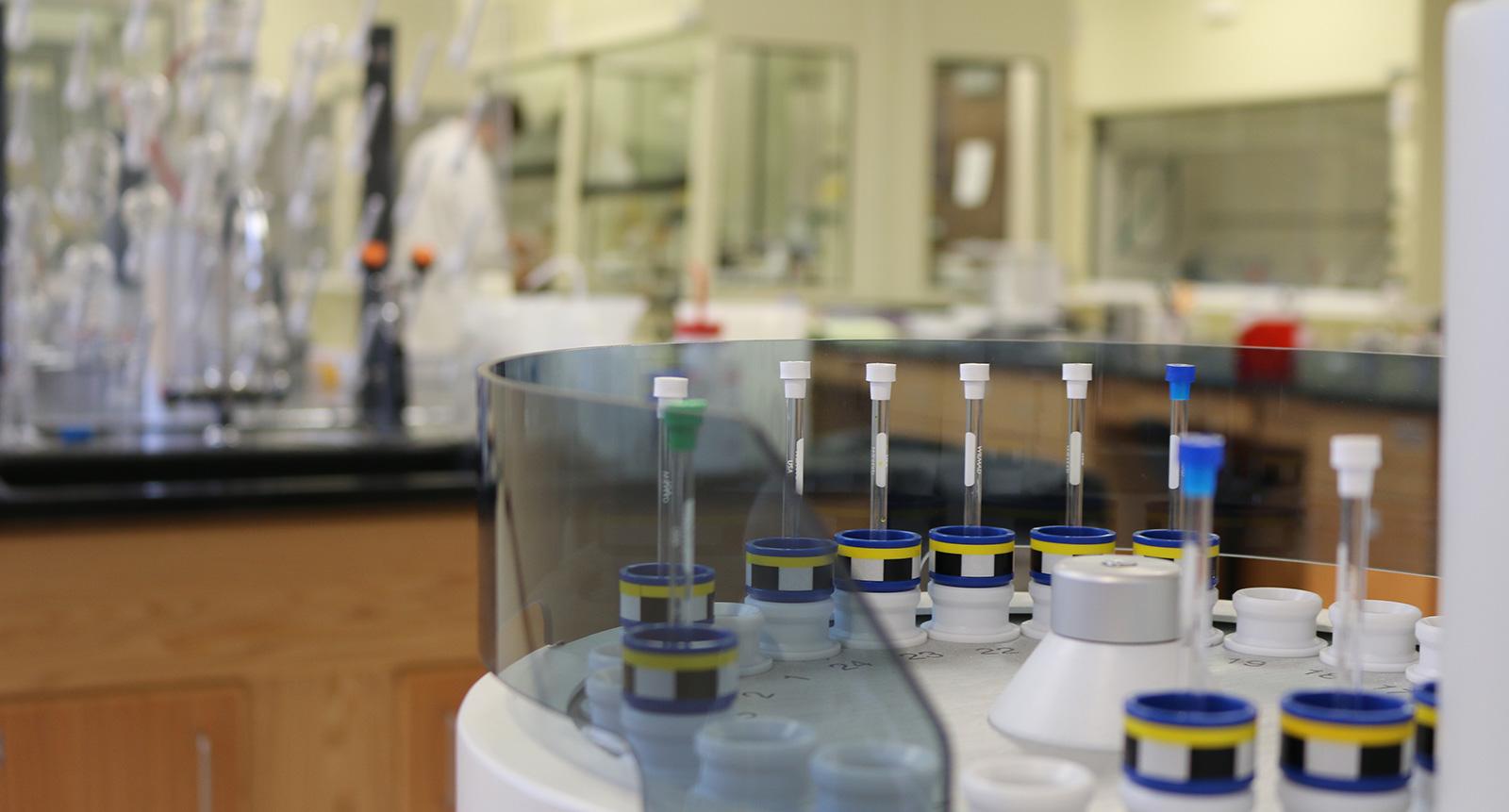by Jay Bouchard
It began with a vision meeting in 2010. Carroll’s chemistry department was in the midst of a new hire and Dr. Colin Thomas, associate professor and chair of the department, called a meeting to address an important question: where do we want this department to be in ten years? “One of the main ideas that came from that meeting is that we needed more involvement in open-ended chemical research,” Thomas said. “We needed to create an environment where students develop their own experimental protocols to answer real chemical questions.”

Four years and three substantial grants later, Carroll has built a state-of-the-art laboratory, commissioned cutting edge instruments, and redesigned the chemistry curriculum. In an effort to create a uniquely innovative laboratory experience and inspire undergraduate research, the chemistry department designed a lab unlike many in the country. This past year, seven upperclassmen chemistry students participated in the department’s inaugural, year-long Integrated Lab. According to Dr. John Rowley, assistant professor of chemistry, the department agreed to strip the lab component from nearly all of the upper-level chemistry classes including physical chemistry and advanced organic and inorganic chemistry. The department then took these labs and combined them into one: the Integrated Lab, an experimental learning lab that typically meets for about eight hours each week.
“It is a less contrived environment than is typical of many undergraduate chemistry courses,” Rowley noted. “Students are no longer working on cookie-cutter type labs where they already know what the result will be.”
During the first semester of the course, each student is assigned their own unique research project. The research projects are inspired by faculty research interests and are designed to incorporate several of the subdisciplines of chemistry. The students spend four weeks on their given research project in which they create experimental objectives, develop protocols, and begin searching for answers to their newly created questions. At the end of the four week period, the students rotate to another project and pass on their findings to the other students in the class.
“The students have a lot of ownership over the direction of the research,” Rowley said. “When the module rotates to a different student, they don’t start over. The projects evolve and grow throughout the course of the semester, like a real science project in an industry lab or in graduate school.”
The lab also requires and encourages collaboration between the students because while each student works independently with freedom uncommon in undergraduate labs, the students must rely on each other’s work, guidance, and support.
“In the Integrated Lab the seven of us became a family,” said Meghan Benda, a 2015 chemistry graduate who plans to pursue graduate studies in sustainable energy or pharmaceutical research. “It was a challenging class, but we were all in it together with and for each other.”
Opens 400 MHz Bruker NMR image in a pop up window In the first semester of the course, students focus on creative problem solving, mastering laboratory technique, and effectively communicating their experimental data in a schematic or graph. In the second semester of the course, students write full manuscripts to document their research. The second semester constitutes the writing intensive component of the course and every four weeks the students write a full journal article.
In the first semester of the course, students focus on creative problem solving, mastering laboratory technique, and effectively communicating their experimental data in a schematic or graph. In the second semester of the course, students write full manuscripts to document their research. The second semester constitutes the writing intensive component of the course and every four weeks the students write a full journal article.
“It’s not typical of an undergraduate curriculum,” said Dr. Caroline Pharr, associate professor of chemistry. “So I think it affords our graduates different and better opportunities before they go on to graduate school and medical school.”
Benda echoed Dr. Pharr’s observation.
“The Integrated Lab is the reason I will be prepared for graduate school. It’s probably the most challenging class I’ve ever taken in my life, but undoubtedly the most gratifying.”
“The Integrated Lab is the reason I will be prepared for graduate school,” she said. “It’s probably the most challenging class I’ve ever taken in my life, but undoubtedly the most gratifying.”
While Benda appreciates the challenging and collaborative nature of the lab, what she liked most was that there was “no leash.”
“In lower level chemistry courses you are kept on such a tight leash and if you stray from the course goals too much you really won’t succeed, but in the Integrated Lab there is absolutely no leash,” Benda said. “It’s the first time I was allowed to be more than a student, but a true scientist. We were able to use every single instrument Carroll has available. We got to decide what was an important use of our time and we got to make our own discoveries and mistakes along the way. It is that type of learning that inspires a higher level of thinking and responsibility as a scientist.”
As Benda explained, she and her fellow students had the opportunity to work with cutting-edge technology and brand-new instruments. The most treasured of these new instruments is Carroll’s Nuclear Magnetic Resonance Spectrometer—the NMR.
From the viewing window of the laboratory, the instrument can be seen in the back left corner. To spectators unversed in the natural sciences, it might be mistaken as a time machine. But for those who understand advanced chemical research, the NMR is a beacon of innovation.
The machine provides structural determination for molecular compounds. As Dr. Pharr explains in layman’s terms, “it is essentially an MRI machine for molecules. It has been amazing in the lab. It has helped me so much with research and has been tremendous for our students.”

At the most basic level, the NMR allows students in the Integrated Lab and in the organic chemistry lab to determine the identity and structure of molecules. According to Dr. David Hitt, assistant professor of chemistry, “NMR allows us to answer one of the most fundamental questions a chemist can ask: how are the atoms in a molecule connected? It’s one thing to look at a house from the street, but another to have the blueprints in your hands to see how it was built.” Carroll is one of the first undergraduate institutions in the country to have this particular model of high efficiency refrigerated, self-cooling NMR instrument.
“While it is easy to get caught up in how expensive and impressive the NMR instrument is, what is truly amazing about Carroll is that theOpens image of Dr. John Rowley and a student in a new window students in the Integrated Lab use all the chemical instrumentation themselves,” Dr. Rowley said. “Learning how to gather and analyze high quality experimental data is an essential skill for graduate school and advanced research.”
students in the Integrated Lab use all the chemical instrumentation themselves,” Dr. Rowley said. “Learning how to gather and analyze high quality experimental data is an essential skill for graduate school and advanced research.”
Carroll’s NMR is a nearly half-million dollar machine which was commissioned as part of a grant from the E.L Wiegand Foundation— the same foundation that funded the biology department’s Wiegand Undergraduate Research Center in 2008.
The E.L Wiegand Foundation was the major donor for the Integrated Lab and was the first funding agency Dr. Thomas approached in 2012. Carroll also received a grant for lab equipment from the Fortin Foundation— which in 2000 funded the construction of the Fortin Science Center on Carroll’s campus, an addition to Simperman Hall where the Integrated Lab is now housed. The Integrated Lab's curricular innovations were funded by a grant from NASA.
“It's not typical of an undergraduate curriculum. So I think it affords our graduates different and better opportunities before they go on to graduate school and medical school.”
— Dr. Caroline Pharr, associate professor of chemistry
Most of the lab’s funding came through in late 2012 and early 2013. By late 2013, the lab was finished and in early 2014, the NMR was commissioned. In the fall of 2014, Meghan Benda and her classmates boarded the Integrated Lab’s maiden voyage under the instruction of Drs. Hitt and Rowley. What began with a vision meeting in 2010 materialized by 2014 into one of the most impressive undergraduate laboratory experiences in the country.
The conception and creation of the Integrated Lab demonstrates Carroll’s continued commitment to academic innovation. “Carroll has been an academically rigorous and valuable institution for many, many years,” reflected Dr. Thomas. “And we are still innovating—we are still being an excellent school.”
The chemistry department is using the Integrated Lab to depart from the traditional pedagogy found at most institutions. Through experimental learning, Carroll’s chemistry graduates are challenged to do high-level research and they emerge from the program equipped with the skills necessary to perform in graduate school and in the professional world.
Benda and her classmates were the first of many students who will have the opportunity to grow in the Integrated Lab. Dozens more students will enjoy this opportunity in the years to come. And thanks to the design of the Integrated Lab, they will do so without a leash.
Learn more about Chemistry at Carroll College
JAY BOUCHARD graduated in 2015 with a major in English writing and a minor in political science. Originally from Goffstown, New Hampshire, he began graduate school at the Medill School of Journalism at Northwestern University in Evanston, Illinois, in the fall of 2015.
,Carroll's new Integrated Lab inspires innovative learning and research for upper-level chemistry students.
,


